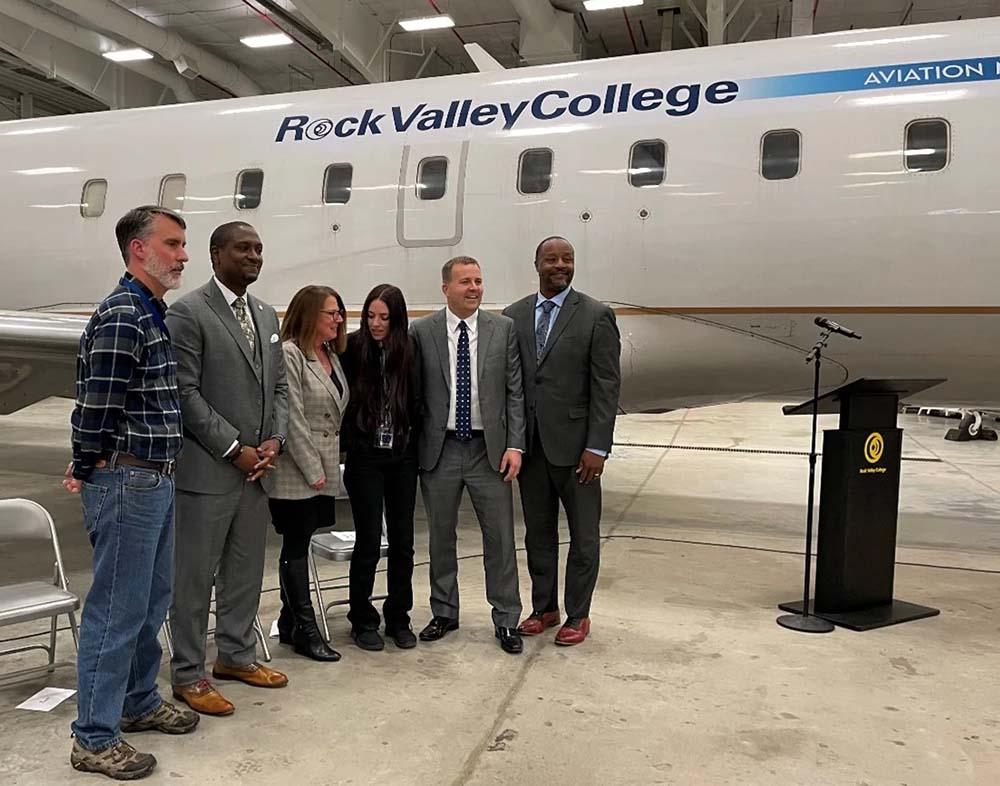
AAR has used grant funding to help Rock Valley College modernize its aviation maintenance curriculum and training tools.
AAR is building on a bevy of MRO workforce pipeline efforts with new initiatives and funding. The goal is to not only better prepare new technicians for careers in MRO, but also to provide a more inclusive environment for technicians already employed at AAR.
The MRO was awarded $2.6 million in grant money from the state of Illinois just over a year ago to expand, develop and implement workforce development and training programs. It has now been awarded a second grant, which will be followed by a final grant in June 2023.
Over the last year, much of this funding has been used to grow its partnership with Rock Valley College (RVC) in Rockford, Illinois. Students in RVC’s Aviation Maintenance Technology program already work in close conjunction with AAR’s Rockford facility, but now the MRO is using new funding opportunities to modernize the school’s curriculum and training tools.
On Oct. 18, AAR used grant money to donate a functional Bombardier CRJ 200 that was formerly operated by SkyWest Airlines to RVC.
“We weren’t asking SkyWest for a pure donation, but we were asking them to do something that I think without the grant funding would’ve been very difficult to do,” says Ryan Goertzen, vice president of workforce development at AAR. After undergoing some component and engine swaps at one of SkyWest’s maintenance facilities, the aircraft was flown to AAR’s Rockford facility and taxied to the aircraft hangar of neighboring RVC.
According to Goertzen, RVC is now the only aviation maintenance school in the U.S. to have a fully operational CRJ 200. He says the aircraft’s more modern avionics systems will play a significant role in enhancing electrical training for RVC’s students. AAR is working with the school to integrate the aircraft into its airframe and powerplant curriculum.
“The educational gap between where [students] were coming out under the current model without this airplane and where they’re going to come out with this airplane will be significantly—if not almost completely—eliminated as they make the transition to an MRO or airline of their choice,” says Goertzen. “It’s a significant mindset shift as well as a shift within the capabilities of the institution itself.”
AAR had already been involved with industry nonprofit Choose Aerospace, which has been developing an aviation maintenance curriculum that could be implemented in high schools and other programs. The nonprofit has now implemented curriculum in 16 schools across the U.S. The curriculum follows the FAA’s new Part 147 standards for training mechanics, which went into effect Sept. 21. Goertzen says the changes will give schools like RVC more flexibility in tailoring curriculum to MRO industry needs.
“Institutions like RVC that have one-up on the other schools because they have an asset [such as the CRJ 200] are going to make that transition significantly quicker,” he says. “There is no doubt that the changes are going to positively impact the type of training, the delivery of training and, ultimately, what kind of technicians come out of the school on the back-end versus what we were receiving prior to the regulatory change.”
AAR’s ongoing grant funding is also going toward its educational programs elsewhere in the U.S. It is hoping to model the success of its programs in south Chicago, where it is partnered with Olive-Harvey College and the Aviation Institute of Maintenance to provide pathways to MRO careers. Goertzen says AAR is in talks with an HBCU in south Florida to set up a similar pipeline model, and it also hopes to set one up in St. Louis.
In Illinois’ neighboring state of Indiana, AAR launched two new fellowship programs in August. AAR is also working with Alaska Airlines to provide workforce pathways. Under the companies’ Flow Through Program, launched summer 2021, candidates are eligible to apply for technician roles at the airline after three years at AAR. Despite the prestige of working at an airline, Goertzen says some candidates have been hesitant to move elsewhere for an airline role, so it is now engaged with Alaska and other airline partners on ways to optimize the program for all parties involved.
“All of our customers are very conscious about taking an employee of ours, because they know that if we lose an employee in the MRO world, that could really have a negative impact on the delivery of their aircraft out of heavy maintenance,” says Goertzen. He adds that the outstanding question is how to partner “in a way that positively impacts both organizations and doesn’t pillage one at the expense of the other or grow one at the expense of the other.”
This year AAR also committed more resources to improving its diversity, equity and inclusion (DEI) engagement. Most of its major U.S. facilities completed DEI education and training this year and it plans to have training completed at its smaller and international sites next year. It also launched a “Train the Trainer” program this year, which Goertzen says will enable continued, more consistent DEI training.
It also started several employee resource groups this year to foster a more inclusive culture, promote social connections and provide growth and development opportunities for underrepresented populations. Its new groups for Asian, Black, LatinX and LGBTQ+ employees will be modeled after its existing groups for veterans and women.
“It’s really cool to see the involvement across the board in each group,” says Goertzen. “It’s definitely provided a positive opportunity for employees to really showcase and be engaged within AAR as a whole, because every employee is important, and this is a way for them to do so in a very positive, impactful way.”





